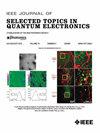对电极在硅基钙钛矿太阳能电池中提高cmos兼容应用的功率转换效率的作用
IF 4.3
2区 工程技术
Q1 ENGINEERING, ELECTRICAL & ELECTRONIC
IEEE Journal of Selected Topics in Quantum Electronics
Pub Date : 2025-04-11
DOI:10.1109/JSTQE.2025.3560119
引用次数: 0
摘要
本文研究了不同反电极材料对硅基钙钛矿太阳能电池(PSCs)整体功率转换效率(PCE)的影响。我们研究了四种不同的结构,使用氟掺杂氧化锡(FTO)作为裸电池,铜(Cu),铝(Al)和高磷掺杂硅片作为反电极。结果表明,含Cu的PSCs的短路电流密度${{J}_{SC}}$为17.11 mA/cm2,而p掺杂的硅和铝的短路电流密度${{J}_{SC}}$值较低,分别为16.19 mA/cm2和16.51 mA/cm2。开路电压(${{V}_{OC}}$)值在所有电池中保持竞争力,FTO实现${{V}_{OC}}$为0.98 V。此外,Cu的最大功率转换效率(PCE)最高,为11.98%,而p掺杂硅的PCE为11.05%。值得注意的是,所有配置的滞后指数都是一致的,平均在15%到16%之间。这一全面的分析为开发高效、cmos兼容的钙钛矿太阳能电池提供了宝贵的见解,可集成到自供电的芯片实验室系统中。本文章由计算机程序翻译,如有差异,请以英文原文为准。
The Role of Counter Electrode in Perovskite Solar Cell on Silicon Substrate to Enhance Power Conversion Efficiency for CMOS-Compatible Applications
This study investigates the impact of various counter-electrode materials on the overall power conversion efficiency (PCE) of perovskite solar cells (PSCs) fabricated on silicon substrates. We examined four distinct configurations using fluorine-doped tin oxide (FTO) as bare cell, copper (Cu), aluminum (Al), and highly p-doped silicon wafers as counter electrodes. The results indicate that the PSCs with Cu achieved the highest short-circuit current density (${{J}_{SC}}$ ${{J}_{SC}}$ ${{V}_{OC}}$ ${{V}_{OC}}$
求助全文
通过发布文献求助,成功后即可免费获取论文全文。
去求助
来源期刊

IEEE Journal of Selected Topics in Quantum Electronics
工程技术-工程:电子与电气
CiteScore
10.60
自引率
2.00%
发文量
212
审稿时长
3 months
期刊介绍:
Papers published in the IEEE Journal of Selected Topics in Quantum Electronics fall within the broad field of science and technology of quantum electronics of a device, subsystem, or system-oriented nature. Each issue is devoted to a specific topic within this broad spectrum. Announcements of the topical areas planned for future issues, along with deadlines for receipt of manuscripts, are published in this Journal and in the IEEE Journal of Quantum Electronics. Generally, the scope of manuscripts appropriate to this Journal is the same as that for the IEEE Journal of Quantum Electronics. Manuscripts are published that report original theoretical and/or experimental research results that advance the scientific and technological base of quantum electronics devices, systems, or applications. The Journal is dedicated toward publishing research results that advance the state of the art or add to the understanding of the generation, amplification, modulation, detection, waveguiding, or propagation characteristics of coherent electromagnetic radiation having sub-millimeter and shorter wavelengths. In order to be suitable for publication in this Journal, the content of manuscripts concerned with subject-related research must have a potential impact on advancing the technological base of quantum electronic devices, systems, and/or applications. Potential authors of subject-related research have the responsibility of pointing out this potential impact. System-oriented manuscripts must be concerned with systems that perform a function previously unavailable or that outperform previously established systems that did not use quantum electronic components or concepts. Tutorial and review papers are by invitation only.
 求助内容:
求助内容: 应助结果提醒方式:
应助结果提醒方式:


